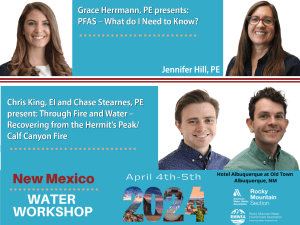2024 New Mexico Water Workshop
DBS&A engineers Chase Stearnes, Grace Herrmann, and Chris King will be presenting at the Rocky Mountain Section of the American Water Works Association (RMSAWWA) 9th Annual 2024 New Mexico Water Workshop taking place from April 4 to 5, 2024, in Albuquerque, New Mexico. The theme for the 2024 Workshop is “Ripple Effect: Addressing Water Scarcity”. Senior Engineer Jennifer Hill will also be in attendance. Learn more about DBS&A’s water resources engineering capabilities.
Abstracts for the presentations are below.
Through Fire and Water – Recovering from the Hermit’s Peak/Calf Canyon Fire
Chase Stearnes, PE and Chris King, EI
The Hermits Peak/Calf Canyon Fire burned a record breaking 341,735 acres destroying 160 homes and over 900 structures. The wildfire affected numerous communities in San Miguel and Mora Counties. There are 14 state-recognized public water systems in the vicinity of the fire and all were impacted in varying degrees, the largest of which is the City of Las Vegas.
When a wildfire occurs, the most obvious impacts are loss of trees and burned down homes. However, even after the fires are contained (this one took four months), lasting impacts affect communities for years. One of the most devastating impacts is the transformation of healthy watersheds from once glorious landscapes and ecosystems to bare soil moonscapes that funnel rainwater and debris downstream.
Northern New Mexico communities experienced a range of challenges from widespread flooding of homes and businesses (Town of Mora) to overloading of surface water supplies making treatment impossible (City of Las Vegas). Every community downstream of the burn area was impacted in some capacity.
Following the disaster, President Biden signed into law the Hermit’s Peak/Calf Canyon Fire Assistance Act. The legislation provided $2.5 billion to compensate New Mexicans for injury and loss of property resulting from the Hermit’s Peak/Calf Canyon Fire. DBS&A evaluated the post-fire runoff increases and recommended flood mitigation actions for many property owners and communities that were impacted. This presentation will provide a summary of wildfire timeline, property-level perspective on the impacts of post-fire flooding, give an overview of HEC-HMS modeling completed, and discuss the small-scale improvements recommended to protect property and infrastructure.
PFAS – What do I Need to Know?
Grace Herrmann, PE
PFAS is a hot button topic these days, and now has become part of the regulatory framework for utilities. PFAS, or per- and polyfluoroalkyl substances, are persistent synthetic compounds used in a variety of industrial and consumer products. In March of 2023, the United States Environmental Protection Agency (EPA) proposed the first national primary drinking water standards for six per- and polyfluoroalkyl substances (PFAS). EPA solicited comments from the public and utilities on the rules related to establishment of Maximum Contaminant levels, monitoring and reporting requirements for public water system.
PFOA and PFOS are no longer produced in the U.S. but continue to be detected in human blood. Newer PFAS that remain in production have been detected in human blood. Exposure to high levels of PFAS in contaminated drinking water may result health effects that include increased cholesterol levels, changes in liver enzymes, hormone disruption and increased risk for thyroid disease, small decreases in infant birth weights, decreased vaccine response in children and increased risk of kidney or testicular cancers.
This presentation will cover the following:
- What is PFAS?
- What is the source of PFAS?
- What are the health effects?
- What are the sampling and reporting requirements?
- What is the sample protocol?
- How much will this cost me?
- What might be the upcoming impacts to wastewater utilities?
Filter and Backwash Improvements at the ATWC Lead to a Dramatic Increase in Filter Run Time
Chase Stearnes, PE; Dr. Kerry J. Howe, PE, BCEE (Howe Water Science, LLC); Lauren Chavez (Anasazi Trails Water Cooperative)
This presentation will describe successful improvements at the Anasazi Trails Water Cooperative (ATWC), a community water system serving about 190 homes in Placitas, New Mexico. ATWC’s water supply is two wells that have arsenic concentrations above the maximum contaminant level (MCL) for drinking water. The ATWC operates an arsenic treatment facility that uses ferric chloride coagulation to adsorb arsenic onto ferric hydroxide floc, followed by sand/anthracite filtration to remove the floc. The system was designed by Orca Water Technologies, which has since gone out of business. The system, which was installed in 2008, has three pressure filters and historically operated with two in parallel and the third in standby. In recent years, the plant has suffered from short filter runs. The plant experienced rapid turbidity breakthrough, which required at least one filter to be backwashed every day. In addition, the washwater system had insufficient capacity and the system overflowed if filters were washed too frequently. These combined operational problems made it challenging for ATWC to consistently meet the arsenic MCL. To improve the plant, the backwash system and filter media were modified. The washwater recovery system was revised by converting sand drying beds into clarifiers that increased the storage capacity for backwash water. The filter modifications involved replacing the underdrains with a design that provided better backwash water distribution, removal of gravel support layers, and increase of the filtration media depth from 16 inches to 30 inches. As a result of the modifications, the filters only need to be backwashed once every 10 days, washwater overflow problems have been eliminated, arsenic removal is more reliable, and operation has been simplified. The improvements represent a small system success story.

